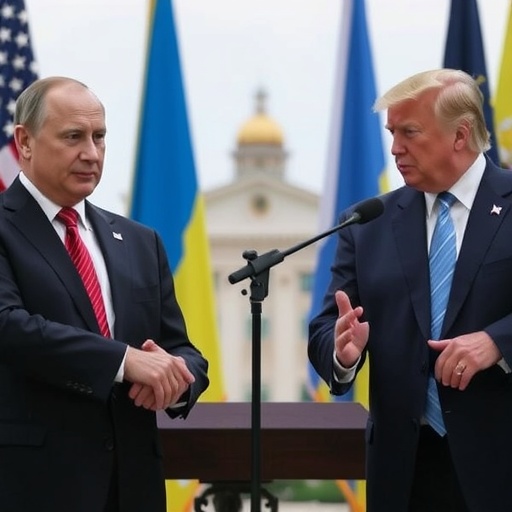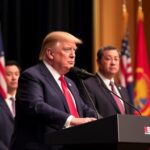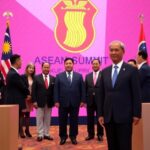US, Russia, and Ukraine Nearing Diplomatic Breakthrough in Three-Year War: Envoy’s Claim Signals Hope Amid Trump’s Delay
In a surprising turn amid the protracted conflict, a senior Russian envoy has declared that the US, Russia, and Ukraine are “quite close to a diplomatic solution” to end the three-year war that has ravaged Eastern Europe. This optimistic statement comes just days after high-level talks in Washington, D.C., where diplomats from all three nations reportedly made significant strides toward peace. However, the momentum faces a hurdle: President Donald Trump has postponed direct negotiations with Russian President Vladimir Putin, insisting on more concrete progress before proceeding.
- Russian Envoy’s Bold Assertion Fuels Global Speculation
- Behind-the-Scenes of Washington Diplomacy: Progress and Sticking Points
- Trump’s Strategic Pause: Why Direct Talks with Putin Are on Hold
- Global Ripples: How Peace Talks Could Reshape Alliances and Economies
- Charting the Path Forward: Next Steps in US-Russia-Ukraine Diplomacy
The revelation, shared by Russia’s special envoy to Ukraine, Rodion Miroshnik, during a press briefing in Moscow, has ignited a wave of cautious optimism across international circles. Miroshnik emphasized that the discussions focused on de-escalation measures, territorial concessions, and security guarantees—core elements that have long stymied peace talks. “We are on the verge of something historic,” he stated, underscoring the urgency as the war enters its fourth year, with over 500,000 casualties reported by the United Nations and economic damages exceeding $1 trillion.
This development arrives at a critical juncture. The invasion of Ukraine by Russia in February 2022 has not only redrawn geopolitical maps but also strained alliances, spiked global energy prices, and triggered widespread humanitarian crises. With winter approaching and aid fatigue setting in among Western allies, the prospect of diplomacy between the US, Russia, and Ukraine could mark a pivotal shift. Yet, Trump’s decision to hold off on a summit with Putin highlights the fragility of these efforts, as domestic politics in the US play into the broader narrative of international relations.
Russian Envoy’s Bold Assertion Fuels Global Speculation
Rodion Miroshnik’s comments have sent ripples through diplomatic channels, positioning the ongoing peace talks as the most promising since the war’s outset. Speaking to reporters outside the Kremlin, the envoy detailed how recent multilateral meetings in Washington bridged longstanding divides. “The US, Russia, and Ukraine have aligned on several key principles,” Miroshnik said, refusing to divulge specifics but hinting at compromises on NATO expansion and Ukrainian neutrality—issues that have been flashpoints in prior negotiations.
According to sources familiar with the talks, who spoke on condition of anonymity, the sessions involved top officials from the US State Department, Russian Foreign Ministry representatives, and Ukrainian delegates led by Foreign Minister Dmytro Kuleba. These discussions, held over two days last week, reportedly covered prisoner exchanges, with over 1,000 captives potentially freed as a goodwill gesture. Miroshnik praised the US for its “constructive role,” a rare compliment amid years of acrimony.
Experts tracking the conflict see this as a potential turning point. “Diplomacy between the US, Russia, and Ukraine has often been performative, but the envoy’s language suggests real concessions,” noted Fiona Hill, a former US National Security Council official and Russia expert at the Brookings Institution. She pointed to Russia’s recent military setbacks in Donbas as a motivator for Moscow to seek an exit strategy, while Ukraine’s resilience, bolstered by $175 billion in US aid since 2022, gives Kyiv leverage at the table.
The envoy’s optimism isn’t without precedent. Back in March 2022, early peace talks in Istanbul collapsed over demands for Ukrainian demilitarization, but current dynamics differ. Russia’s economy, hit by sanctions that have shrunk GDP by 2.1% in 2023 per IMF estimates, and Ukraine’s urgent need for reconstruction funding—projected at $486 billion by the World Bank—create mutual incentives for resolution.
Behind-the-Scenes of Washington Diplomacy: Progress and Sticking Points
The Washington talks, hosted discreetly at the State Department, marked a rare convergence of US, Russia, and Ukraine envoys under one roof. Officially described as “preliminary consultations,” these sessions delved into frameworks for a ceasefire, including monitored buffer zones along the 1,000-mile front line. A leaked memo, cited by Reuters, indicated agreement on humanitarian corridors to evacuate civilians from besieged cities like Kherson and Mariupol, where shelling has displaced over 6 million people.
Key to the discussions was the US’s role as a mediator, leveraging its influence over both NATO commitments and sanctions relief. Secretary of State Antony Blinken, who chaired parts of the talks, reportedly pressed Russia on withdrawing forces from occupied territories in Luhansk and Donetsk, while assuring Moscow that Ukraine would not pursue immediate EU or NATO membership—a concession long demanded by Putin.
From Ukraine’s perspective, the talks addressed reparations. Kyiv has quantified war damages at $150 billion in infrastructure alone, with proposals for a UN-administered fund drawing from frozen Russian assets worth $300 billion. “Peace talks must include justice,” Ukrainian President Volodymyr Zelenskyy tweeted post-meeting, emphasizing that any deal must uphold Ukraine’s sovereignty.
Challenges persist, however. Russia’s insistence on recognizing Crimea as its territory, annexed in 2014, remains a non-starter for Ukraine and the US. Additionally, intelligence reports suggest Putin is wary of appearing weak domestically, where state media portrays the war as a defense against Western aggression. Despite these hurdles, Miroshnik claimed the parties are “90% aligned” on a roadmap, potentially leading to a formal summit within months.
Statistics underscore the stakes: The war has caused 10 million Ukrainian refugees, disrupted 30% of global grain exports, and escalated NATO spending to $1.3 trillion annually. As one European diplomat quipped, “These peace talks aren’t just about borders; they’re about stabilizing the world order.”
Trump’s Strategic Pause: Why Direct Talks with Putin Are on Hold
President Trump’s announcement via Truth Social that he would delay a one-on-one with Putin has tempered the excitement surrounding the diplomatic overtures. Citing “insufficient progress on core issues,” Trump argued that rushing into talks could undermine US leverage. “We need ironclad commitments from Russia before I sit down with Putin,” he posted, echoing his campaign promises to end the war “in 24 hours” through tough negotiations.
This hesitation aligns with Trump’s foreign policy playbook, which prioritizes deal-making from strength. Advisors close to the White House reveal that internal polls show 62% of Americans favor a quick resolution, per a recent Gallup survey, but only if it doesn’t involve territorial losses for Ukraine. Trump’s delay may also be tactical, pressuring Russia to offer more on sanctions relief— a lever the US holds firmly, with over 16,000 measures in place since 2022.
Critics, including Senate Foreign Relations Committee Chair Ben Cardin, warn that the postponement risks stalling momentum. “Diplomacy between the US, Russia, and Ukraine thrives on continuity,” Cardin said in a statement. Meanwhile, Putin’s spokesperson, Dmitry Peskov, responded coolly, stating Moscow respects the US timeline but expects “reciprocal steps” soon.
Behind this decision lies broader US domestic pressures. With midterm elections looming, Trump faces scrutiny from both hawkish Republicans pushing for sustained aid to Ukraine and isolationists advocating withdrawal. A recent Congressional Research Service report estimates US support at $61 billion in military aid alone, fueling debates on fiscal responsibility.
Trump’s approach contrasts with the Biden administration’s multilateral strategy, which emphasized coalitions like the Ukraine Defense Contact Group involving 50+ nations. Yet, his personal rapport with Putin—forged during the 2018 Helsinki summit—could prove invaluable if talks resume. Analysts speculate a potential venue in neutral Switzerland or Turkey, building on Istanbul’s 2022 efforts.
Global Ripples: How Peace Talks Could Reshape Alliances and Economies
The potential diplomatic solution reverberates far beyond the US, Russia, and Ukraine, promising to realign global power dynamics. For Europe, a resolution could ease energy woes; Russia’s cutoff of gas supplies has driven prices up 300% since 2021, per Eurostat, forcing nations like Germany to pivot to LNG imports costing billions.
In Asia, China—Russia’s key ally—stands to benefit from stabilized trade routes, while India, a neutral player, has already mediated grain deals under the Black Sea Initiative, exporting 33 million tons since July 2022. The UN Security Council, paralyzed by vetoes, could see renewed functionality, addressing conflicts from Gaza to Sudan.
Economically, peace talks signal investor confidence. The Kyiv Independent reported a 15% stock surge in Ukrainian firms post-Washington news, while Russian ruble stabilized at 92 to the dollar. The World Economic Forum estimates a truce could add $1.6 trillion to global GDP over five years by restoring supply chains.
Humanitarian angles are equally compelling. Organizations like the Red Cross have facilitated 1,200 prisoner swaps, but a full deal could repatriate millions. Quotes from affected families, such as a Kharkiv mother whose son is missing, highlight the emotional toll: “Diplomacy isn’t abstract; it’s our lives hanging in the balance.”
Security-wise, NATO’s eastern flank, bolstered by 300,000 troops, might de-escalate, though experts like those at the Atlantic Council caution against complacency. “A deal must include verifiable arms controls,” warned Samuel Charap, a RAND Corporation senior political scientist.
Charting the Path Forward: Next Steps in US-Russia-Ukraine Diplomacy
As the dust settles from the Washington talks, eyes turn to upcoming milestones that could propel peace talks forward. Envoys from the US, Russia, and Ukraine are slated for virtual follow-ups next week, focusing on drafting a non-binding memorandum of understanding. This document, if successful, would outline timelines for troop withdrawals and international monitoring by OSCE observers.
Zelenskyy’s upcoming address to the UN General Assembly in September may serve as a platform to rally support, potentially unveiling a “victory plan” that integrates diplomatic gains. Meanwhile, the EU’s pledge of €50 billion in loans to Ukraine, tied to reforms, incentivizes Kyiv to engage constructively.
For Russia, internal pressures mount; parliamentary elections in 2024 could test Putin’s grip if the war drags on. US intelligence suggests Moscow is exploring backchannel talks via Turkey, which hosted preliminary rounds in 2022. Trump’s team has hinted at incentives like partial sanctions easing in exchange for demilitarization pledges.
Looking ahead, scenarios range from a frozen conflict—similar to 2014’s Minsk agreements—to a comprehensive treaty. The International Crisis Group outlines three pathways: immediate ceasefire with delayed territorial talks, phased de-escalation over 12 months, or UN-mediated arbitration. Whichever unfolds, the envoy’s claim underscores a shared exhaustion with conflict.
Stakeholders emphasize inclusivity; civil society groups in Ukraine demand input, while Russian opposition voices, though silenced, leak calls for peace via Telegram channels. As one analyst put it, “These peace talks could redefine the post-Cold War era, but only if trust is rebuilt brick by brick.” The world watches, hopeful yet vigilant, for the next diplomatic breakthrough.








